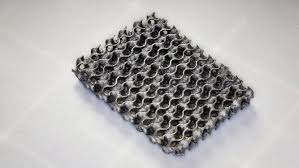
Breaking News
 Did Barron Trump Make $192 Million Off Insider Trading??
Did Barron Trump Make $192 Million Off Insider Trading??
 Here it is: Seditious conspiracy -- captured on videotape in just thirty-eight seconds.
Here it is: Seditious conspiracy -- captured on videotape in just thirty-eight seconds.
 I have received a hard copy of the report on JFK's assassination from the Ambassador of Russia..
I have received a hard copy of the report on JFK's assassination from the Ambassador of Russia..
 Black-?Market Activism: Agorism and Samuel Edward Konkin III
Black-?Market Activism: Agorism and Samuel Edward Konkin III
Top Tech News
 3D Printed Aluminum Alloy Sets Strength Record on Path to Lighter Aircraft Systems
3D Printed Aluminum Alloy Sets Strength Record on Path to Lighter Aircraft Systems
 Big Brother just got an upgrade.
Big Brother just got an upgrade.
SEMI-NEWS/SEMI-SATIRE: October 12, 2025 Edition
 Stem Cell Breakthrough for People with Parkinson's
Stem Cell Breakthrough for People with Parkinson's
 Linux Will Work For You. Time to Dump Windows 10. And Don't Bother with Windows 11
Linux Will Work For You. Time to Dump Windows 10. And Don't Bother with Windows 11
 XAI Using $18 Billion to Get 300,000 More Nvidia B200 Chips
XAI Using $18 Billion to Get 300,000 More Nvidia B200 Chips
 Immortal Monkeys? Not Quite, But Scientists Just Reversed Aging With 'Super' Stem Cells
Immortal Monkeys? Not Quite, But Scientists Just Reversed Aging With 'Super' Stem Cells
 ICE To Buy Tool That Tracks Locations Of Hundreds Of Millions Of Phones Every Day
ICE To Buy Tool That Tracks Locations Of Hundreds Of Millions Of Phones Every Day
 Yixiang 16kWh Battery For $1,920!? New Design!
Yixiang 16kWh Battery For $1,920!? New Design!
 Find a COMPATIBLE Linux Computer for $200+: Roadmap to Linux. Part 1
Find a COMPATIBLE Linux Computer for $200+: Roadmap to Linux. Part 1
Scientists 'Cultivate' Metal Instead of 3D Printing it–and it's 20x Stronger

The concept aims to power the production of unique sensors, biomedical devices, or energy conversion and storage components.
Scientists at the Ecole Polytechnique Fédérale de Lausanne, in Switzerland, have created dense, high-strength structures by injecting hydrogel with metal salts of various minerals like iron and copper. Early results show materials 20-times stronger with much less shrinkage than earlier methods.
As novel a concept as "cultivating metal" sounds like, it's actually been done before, but challenges presented themselves which could not be overcome in these previous experiments.
They involved vat photopolymerization—a type of 3D printing that sees pouring a light-reactive liquid resin into a container and then solidifying specific areas with a laser or ultraviolet light to create a shape. However, because this method only works with light-sensitive polymers, its practical uses are limited.
Daryl Yee, who leads the Laboratory for the Chemistry of Materials and Manufacturing at EPFL's School of Engineering, said these earlier approaches have major flaws.
"These materials tend to be porous, which significantly reduces their strength, and the parts suffer from excessive shrinkage, which causes warping," he told his university press.
To address these issues, Yee and his team have introduced a new approach described in their paper published in Advanced Materials. Instead of hardening a resin already mixed with metal compounds, the researchers first 3D print a framework using a simple water-based gel known as a hydrogel. They then soak this "blank" structure in metal salts, which are chemically converted into tiny metal-containing nanoparticles that spread throughout the gel. Repeating this process multiple times allows them to create composites with very high metal content.
After 5–10 of these "growth cycles," the remaining hydrogel is removed through heating, leaving behind a dense metal or ceramic object that precisely matches the shape of the original printed gel. Because the metal salts are added only after printing, the same hydrogel template can be used to make a variety of different metals, ceramics, or composite materials.



